Osteoarthritis is an inflammatory disease of articular cartilage in individuals and often studied in the context of ageing (Loeser, 2010). Clinical issues that are seen with ageing, geriatric patients are decreased proprioception and muscle atrophy (Goldberg et al, 2021). Recent clinical research suggests that weight loss, physical activity, and increasing muscle mass and strength are the only effective strategies for reducing pain and enhancing mobility in subjects with osteoarthritis (Messier et al, 2004) Osteoarthritis can affect any joint, including hips, elbows, and stifles, but also vertebral facet joints, carpal joints, tarsal joints, and even meta-carpophalangeal and metatarsophalangeal joints (Franklin et al, 2009).
Part 1 of this two part article looked at the causes of osteoarthritis and its detection by owners and veterinary professionals, and discussed the importance and methods of pain management. Part 2 will look at the physical rehabilitation modalities available for treating dogs with osteoarthritis.
Physical rehabilitation for osteoarthritic dogs
When the osteoarthritic patient comes into the hospital or facility, they need to be provided with plenty of cushions and bedding suitable for arthritic joints and backs (Figure 1). Geriatric dogs need to be taken out to relieve themselves more often than their younger counterparts, as they physically cannot hold their bowels and bladder in the same way as younger canine patients.
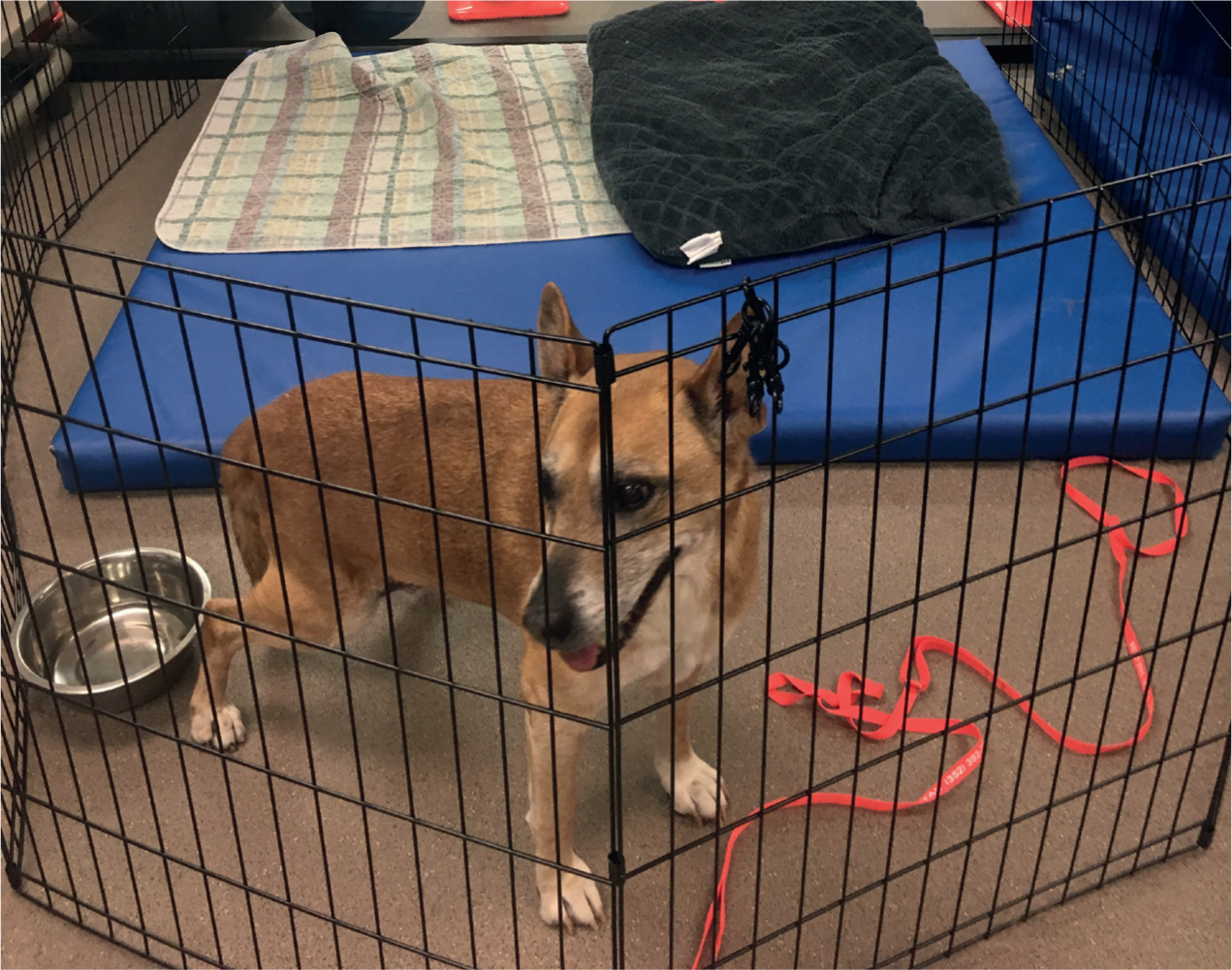
Evidence for physical rehabilitation in humans
Regular physical training, and particularly multicomponent training (MCT), has demonstrated many health benefits to patients with osteoarthritis (Brown, 2012). MCT includes endurance training, muscle strengthening, balance exercises, and/or stretching (i.e. flexibility training) and/or coordination training in adults aged 65 years or over. Reduced mobility is an independent risk factor for morbidity, hospitalisation, disability, and mortality (Pahor et al, 2014; Bouaziz et al, 2016).
In the treatment of chronic disease, such as degenerative joint disease or conformational abnormalities, rehabilitation should be considered an important component of an overall long-term treatment strategy (Edge-Hughes, 2007; Epstein et al, 2015).
Evidence for physical rehabilitation in animals
There are four key areas of physical rehabilitation available to the geriatric veterinary patient, which include manual therapy, electrotherapy, hydrotherapy, and clinical/home exercise programmes.
Manual therapy
Manual therapy that veterinary technicians/nurses can perform (Jurek, 2011) include daily muscle stretches that can be taught to the owner. Passive range of motion (PROM) supports joint range and muscle length. This is performed after the patient is ‘warmed up’ by massage or an activity, such as brisk walking, if possible, or movement. If a patient has pain issues, they should not be stretched to the utmost limits.
Electrotherapy includes:
- Laser therapy is another name for photobiostimulation, which increases cellular ATP and decreases nerve signaling of pain (Shaw and Brown, 2015)
- Therapeutic ultrasound causes deep heating of tissues, is anti-inflammatory, reduces pain/spasm, and increases tissue extensibility (Medina and Davies, 2015)
- Shockwave therapy uses high energy sound waves to stimulate tissues to repair themselves. There are four machines available: electromagnetic; electrohydraulic; piezo-electric; and radial. Higher intensity devices offer more evidence, more focused energy, but require sedation (Stramel and Stramel, 2015)
- Pulsed electromagnetic field therapy (PEMF) uses microcurrents to decrease pain and inflammation. Veterinary-focused research studies have demonstrated benefits of PEMF treatment for osteoarthritis. A non-targeted PEMF device (low frequency) was found to lessen clinical signs of osteoarthritis in dogs after 20 18-minute treatments (Gaynor et al, 2018)
- Neuromuscular electrical stimulation (NMES) is a term used interchangeably with electrical stimulation, transcutaneous electrical nerve stimulation (TENS), and functional electrical stimulation (FES). This therapy is often used in neurological patients. It can improve muscle strength, increase range of movement, decrease pain, and muscle spasm, and promote soft tissue healing and fracture repair (Sprague and Goldberg, 2015).
Hydrotherapy or aquatic therapy
Hydrotherapy includes both the underwater treadmill and swimming. In the geriatric patient, hydrotherapy must be approached slowly and with caution. These activities are strenuous on the cardiovascular system (Goldberg and Tomlinson, 2017). Obese patients become easily fatigued therefore, respiration must be monitored. The first session should allow the patient to become accustomed to the water. The first therapy water session should be walking for 1–2 minutes maximum. Buoyancy aids, limb or body facilitation, and proprioceptive aids can all be applied to enhance the treatment (Goldberg and Tomlinson, 2017). After hydrotherapy, many dogs need to urinate again. Be sure to allow them to walk outside to relieve themselves.
Swimming can be good therapy for the elderly patient with the same caveats as walking on the underwater treadmill, but is more suitable for elderly patients that have been competent swimmers, as the stress and energy consumption levels will be too arduous for the inexperienced swimmer. Never leave the pet unattended in the underwater treadmill or pool. They will probably need a life jacket (referred to as a buoyancy aid).
Patients that have poor swallowing reflexes should not be swimming because they may aspirate water. Someone should always be inside the treadmill with these patients in case of stumbling, choking or accidental aspiration.
Dogs that can benefit from hydrotherapy are those that have orthopaedic problems (cranial cruciate disease, hip dysplasia, postoperative recovery, and osteoarthritis) (Goldberg, 2015), and neurological problems (intervertebral disc disease, degenerative myelopathy, those that range from quadriplegia to mild muscular weakness (Prydie and Hewitt, 2015). Hydrotherapy can help geriatric athletes maintain strength and aerobic fitness to compete in the senior division of sports (Egan and Fitzpatrick, 2015) (Box 1).
Box 1.Benefits related to hydrotherapy for the geriatric patient
- Decreases pain
- Osteoarthritis (chronic and acute on chronic)
- Cancer
- Decreases weight bearing stress
- Weight off the joints
- Muscle relaxation
- Enhances the ability of the muscles to contract and stretch
- Reduces oedema in distal limbs
- Enhances coordination and balance
- Opportunity to strengthen core
- Increase metabolism
- Beneficial for overweight dogs
- Improves muscle tone and strength
- Increased flexion of forelimb and rear limb compared with land treadmill or walking
- Increases superficial circulation
Clinical or home exercise programmes (land exercises)
Providing exercises for the pet to do both in the clinic and at home can help them maintain mobility for as long as possible.
Balance exercises
Balance can be improved by weight-shifting/postural perturbations that help to improve strength, and control. Make sure that the patient is standing on a high traction surface. Be sure to counsel clients about gentle motions being effective and to avoid unbalancing their pet to the point of a fall risk (Goldberg and Tomlinson, 2015). The number one exercise for balance and proprioception (knowing where your feet are placed) are cavaletti rales or poles (Figure 2).
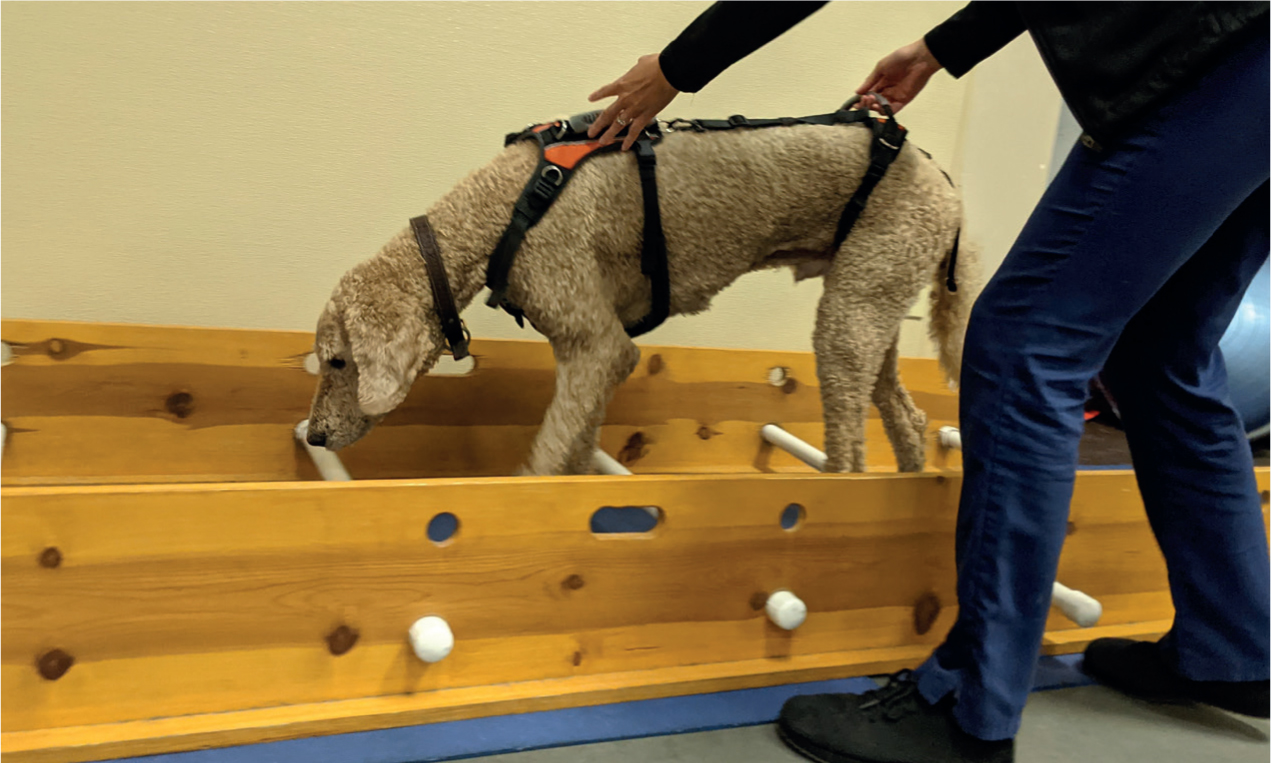
Cavaletti poles can be placed on the ground for old patients that cannot pick up their feet or they can be slightly elevated off the ground as the patient progresses. The author likes to advise owners to place a garden hose, snaked on the grass, and walk the dog back and forth so they learn to pick up their feet. Backing up practice (backwards walking) can also help home mobility.
Strengthening exercises
Strengthen limbs by placing paws on targets (such as a raised surface) to improve accuracy. Start with low targets such as a rubber mat and move on to a higher step, squishy foam pad, or even a balance disc. Tail exercises can help to improve rear awareness and strengthen the pelvic floor muscles. Stimulate tail motion with brushing the fur back at the tip of the tail or gentle squeezing (Goldberg and Tomlinson, 2017). Walking on uneven surfaces can be a challenge for older pets but can also be used as a therapeutic exercise. Placing several cushions, a mattress or varying height soft objects on the floor to walk the dog over are useful as uneven surfaces.
Flexibility exercises
Flexibility is improved by weaving around obstacles in a figure-of-eight pattern. Side steps are another strength and balance exercise. Competence with these two exercises can improve ability to turn in tight spaces in the house (Goldberg and Tomlinson, 2017). Active stretches for treats (cookie reaches) will improve flexibility but also challenge balance and subtly strengthen muscles. Stretches can be nose to hip, for example, down between front legs to arch back from a standing position (crunches), nose to rear toes (Goldberg and Tomlinson, 2017).
Endurance exercises
Endurance is required in activities such as climbing stairs or jumping into a car. Pets can practice for stair climbing by hill climbing (serpentine up the hill first if easier) combined with step up and over low obstacles and progressing to practicing low stairs in the clinic or at home. Getting into a vehicle and onto furniture can be broken down into learned steps. A pet can be taught to step their front feet up on a raised level (equivalent of the bed, couch, or car) and then wait for assistance in the rear (Goldberg and Tomlinson, 2017).
Activities of daily living
Train the muscles in the way they intend to be used. Functional movement strengthens a movement rather than a muscle. This is imperative for activities of daily living (ADL) (Kirkby Shaw, 2018).
Examples of ADLs are:
- Down to stand movement — the dog is lying in lateral recumbency. Encourage the dog to move from lateral to a sternal position. From sternal to then get up and stand.
- Stand to eat, drink movement — required are core postural muscles to stand and support head. Balance is required for this position
- Stand to down movement — this is not just falling into a lying position. It is controlled movement. This can require a lot of effort. Eccentric contractions are what is needed
- Walking movement — should be carried out on different surfaces of varying height. Incline/decline should be used (outdoor hills are excellent). This movement encourages endurance
- Posture to urinate movement — requires isometrics and balance. Male and female differences — females' hip flexion; males hip extension
- Posture to defecate movement — slightly different posture from urination. Abdominal contractions are required
- Stairs movement — requires up versus down movements Surfaces should not be slick (can cover with mats or carpeting) If stairs are an ADL, then the patient should do multiple sets daily
- Jumping movement up versus down motion that can be used getting in to and out of a car — does this require motivation on the dog's part? A ramp may be the best way to assist if the patient cannot jump.
Low endurance patients
Low endurance patients must be given appropriate rest periods between repetitions and between exercises. An example would be walking to mailbox and back, rest 3 minutes to an hour, and repeat, rather than walk twice as far at one time. A sit to stand then rest example would be one sit to stand, walk 5 feet, up to 20 feet, then rest. With sit to stands, the owner can work up to five, 10 to 20 in a row, but slowly to build strength.
Remember that the geriatric patient requires activity modification. Regular, controlled, low-impact exercise such as walking, hiking, swimming, nose-work. Gradual increase in duration and intensity of exercise. Pacing of exercise would include short bouts followed by rest. Incorporate therapeutic exercises into daily activities. Encourage the use of a journal for the owner to keep track of what is performed. At each rehabilitation visit, the owner can show the journal to the nurse and veterinarian so they can add suggestions or cut back on specific exercises if needed.
Environmental modification can be a huge help for geriatric patients. Raised food and water bowls help the dogs with cervical osteoarthritis and relieve pain. Yoga mats help to prevent slipping on slick flooring, aiding the dog with joint osteoarthritis (Figure 3). Carpet on stairs can help to prevent slipping going up and down stairs, which can be a difficult activity for the dog. Ramps or stairs to get on a couch or bed or into a car are helpful for the old dog that has a problem jumping onto something (Figure 4).
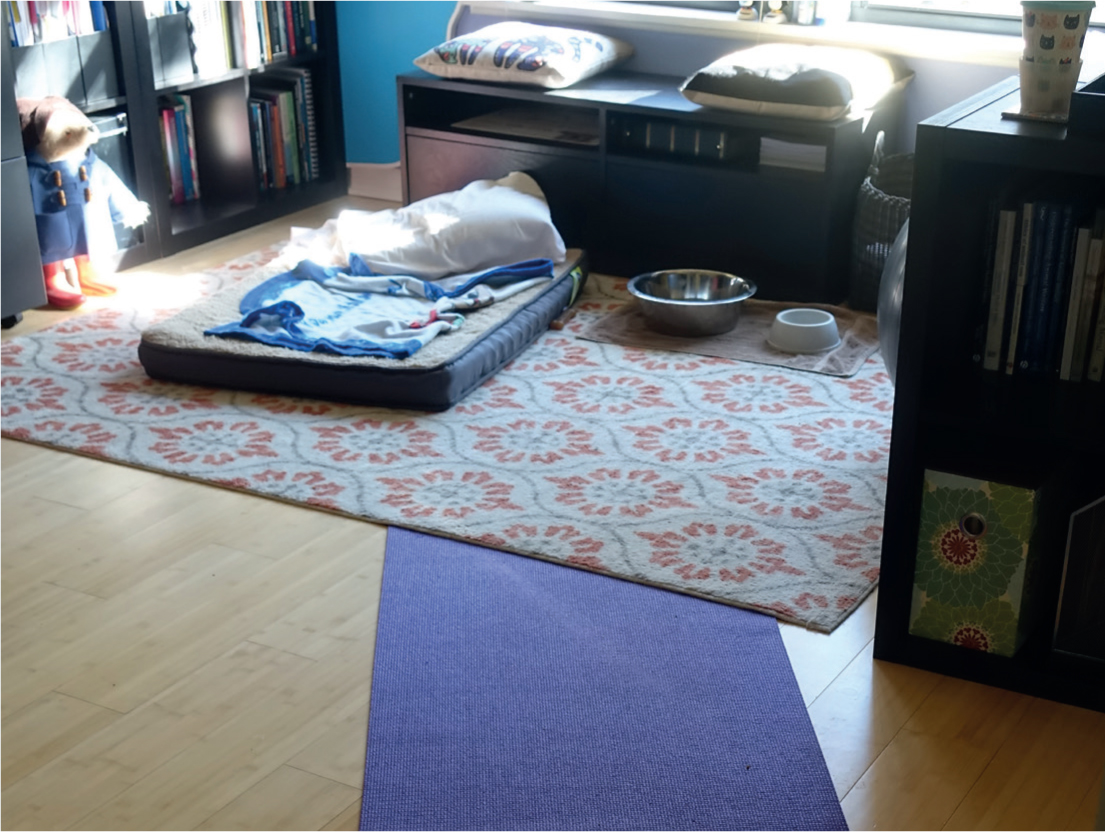
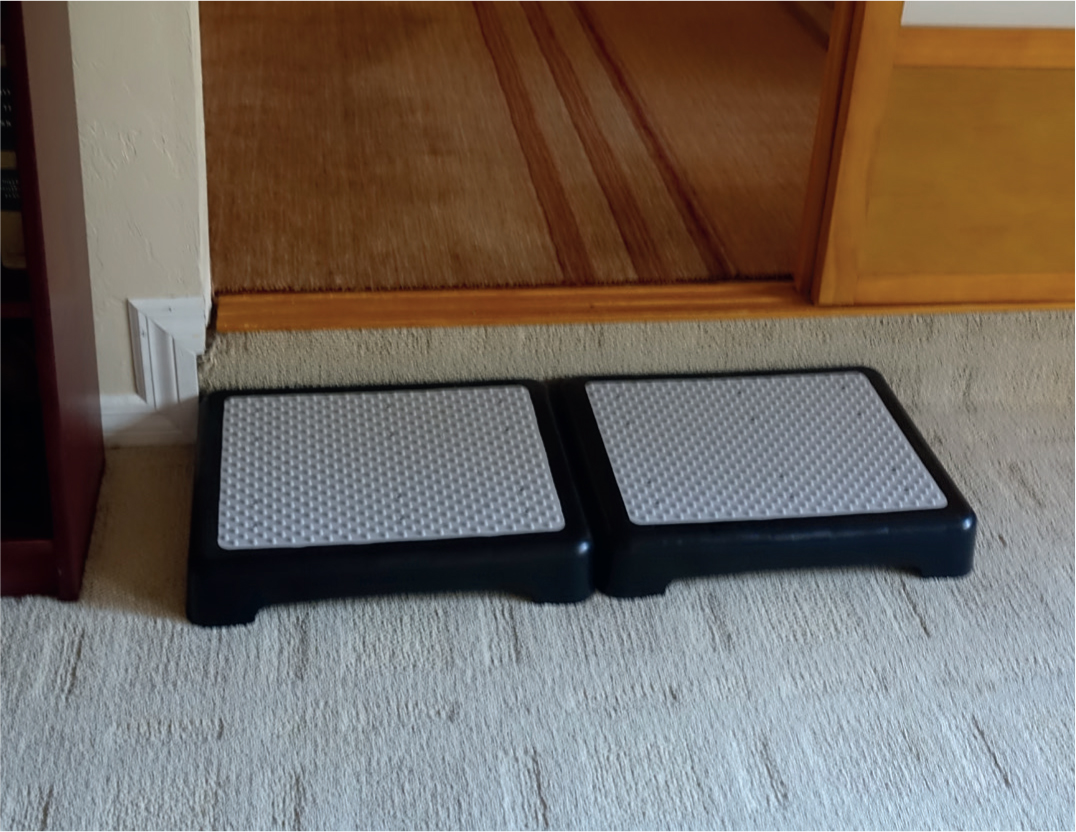
Orthopeadic bedding for cushioning of old joints helps to create a more comfortable resting and sleeping area. Make sure to suggest to the owner that their pet's nails are kept short since long nails impair walking on any surface. A cart for trips to a park or beach enable the dog to enjoy outings with the family (Figure 5).
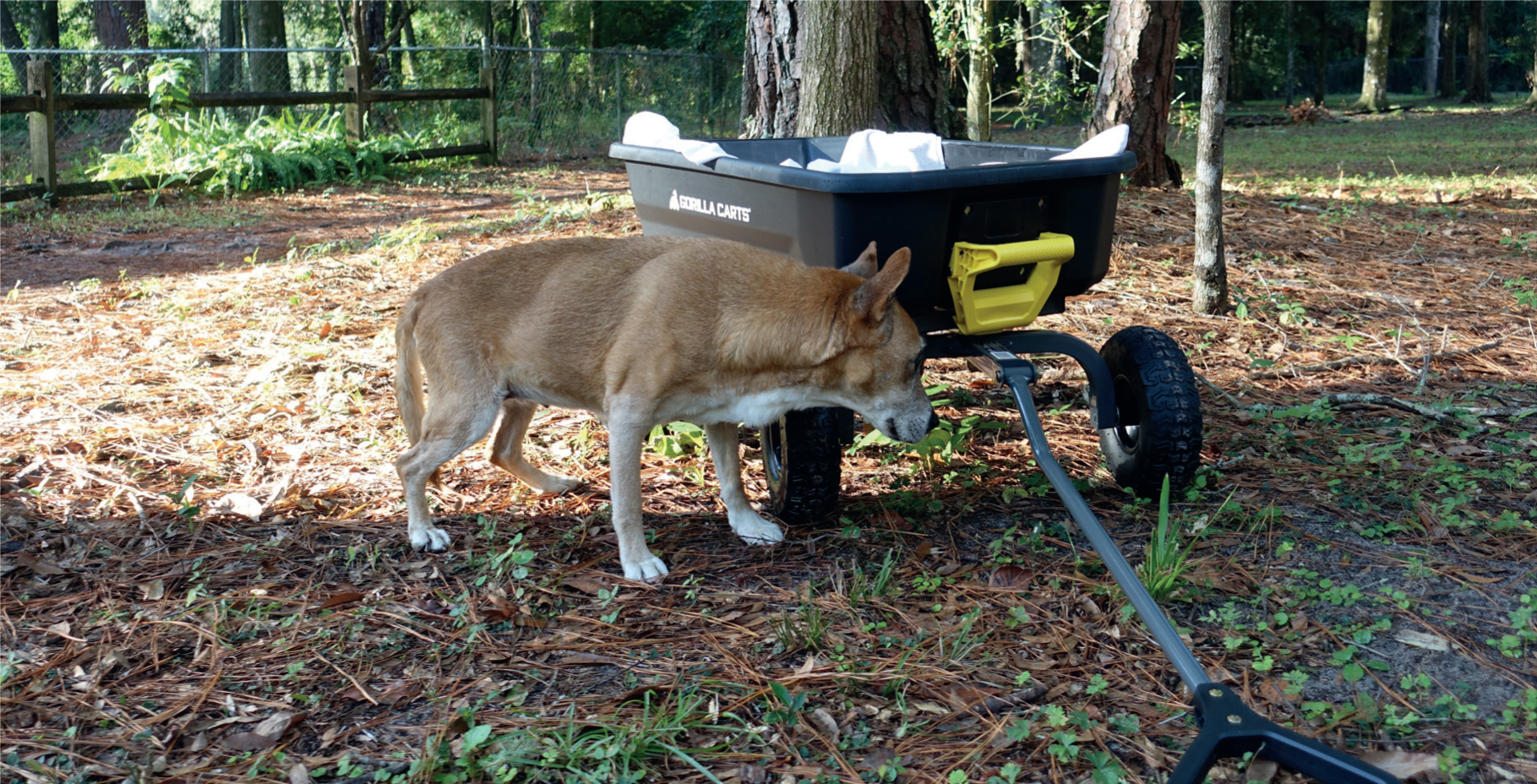
Conclusion
Rehabilitation objectives for the osteoarthritis geriatric patient include managing pain, improving mobility and strength, providing appropriate assistive devices to promote independent ambulation, and modifying the patient's home environment to provide adequate traction, bedding, and obstacle-free space for ambulation.
While osteoarthritis progression cannot be stopped, it can be delayed through the use of physical rehabilitation, in addition to the pain management discussed in part 1 of this two part article. Educating colleagues and clients to all that is currently available will encourage the best quality of life for canine patients.
KEY POINTS
- Physical rehabilitation is a major part of maintaining quality of life, enabling the geriatric patient to live life to the fullest.
- Manual therapy, as well as electrotherapy, provide pain relief for tissues and movement, which is important to geriatric osteoarthritic patients.
- Hydrotherapy enables geriatric joints to move more easily because of the buoyancy that water provides.
- Land exercises allow the geriatric patient to continue to have mobility and perform their normal activities of daily living.
- Keeping a journal of home performance allows the owner to discuss with the veterinary team progress or regression for a specific patient.
- Environmental modifications cannot be emphasised enough, and provide comfort for the geriatric, osteoarthritic patient.


